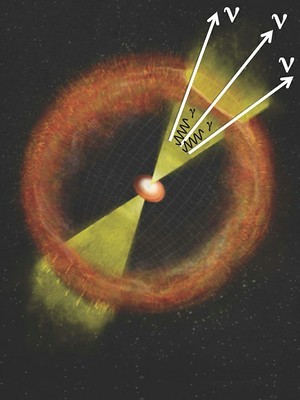.

This illustration is an example of a hidden cosmic-ray accelerator. Cosmic rays are accelerated up to extremely high energies in dense environments close to black holes. High-energy gamma rays (marked by the “Y” gamma symbol) are blocked from escaping, while neutrinos (marked by the “V”nu symbol) easily escape and can reach the Earth. Credit: Bill Saxton at NRAO/AUI/NSF, modified by Kohta Murase at Penn State University
.
The sources of the high-energy cosmic neutrinos that are detected by the IceCube Neutrino Observatory buried in the Antarctic ice may be hidden from observations of high-energy gamma rays, new research reveals. These high-energy cosmic neutrinos, which are likely to come from beyond our Milky Way Galaxy, may originate in incredibly dense and powerful objects in space that prevent the escape of the high-energy gamma rays that accompany the production of neutrinos. A paper describing the research will be published in the early online edition of the journal Physical Review Letters on February 18, 2016.
"Neutrinos are one of the fundamental particles that make up our universe," said Kohta Murase, assistant professor of physics and of astronomy and astrophysics at Penn State and the corresponding author of the studies. "High-energy neutrinos are produced along with gamma rays by extremely high-energy radiation known as cosmic rays in objects like star-forming galaxies, galaxy clusters, supermassive black holes, or gamma-ray bursts. It is important to reveal the origin of these high-energy cosmic neutrinos in order to better understand the underlying physical mechanisms that produce neutrinos and other extremely high-energy astroparticles and to enable the use of neutrinos as new probes of particle physics in the universe."
Neutrinos are neutral particles, so they are not affected by electromagnetic forces as they travel through space. Neutrinos detected here on Earth therefore trace a direct path back to their distant astrophysical sources. Additionally, these neutrinos rarely interact with other kinds of matter -- many pass directly through the Earth without interacting with other particles -- making them incredibly difficult to detect, but ensuring that they escape the incredibly dense environments in which they are produced.
The high-energy cosmic neutrinos detected by IceCube are believed to originate from cosmic-ray interactions with matter (proton-proton interactions); from cosmic-ray interactions with radiation (proton-photon interactions); or from the decay or destruction of heavy, invisible "dark matter." Because these processes generate both high-energy neutrinos and high-energy gamma rays, the scientists compared the IceCube neutrino data to high-energy gamma rays detected by the Fermi Gamma-ray Space Telescope. "If all of the high-energy gamma rays are allowed to escape from the sources of neutrinos, we had expected to find corresponding data from IceCube and Fermi," said Murase. In previous papers, including one that was featured as an Editorial Suggestion in Physical Review Letters in 2015, Murase and his colleagues showed the power of such a "multi-messenger" comparison. Now, the researchers suggest that the new neutrino data collected by IceCube has lead to intriguing contradictions with the gamma-ray data collected by Fermi.
"Using sophisticated calculations and a detailed comparison of the IceCube data with the gamma-ray data from Fermi has led to new and interesting implications for the sources of high-energy cosmic neutrinos," said Murase. "Surprisingly, with the latest IceCube data, we don't see matching high-energy gamma-ray data detected by Fermi, which suggests a 'hidden accelerator' origin of high-energy cosmic neutrinos that Fermi has not detected."
In order to explain the multi-messenger data without any of the intriguing contradictions, the scientists propose that the high-energy gamma rays must be blocked from escaping the sources that created them. The researchers then asked what kinds of astrophysical events could produce high-energy neutrinos but also could suppress the high-energy gamma rays detectable by Fermi. "Interestingly, we found that the suppression of high-energy gamma rays should naturally occur when neutrinos are produced via proton-photon interactions," said Murase. The low-energy photons that interact with protons to produce neutrinos in these events simultaneously prevent high-energy gamma rays from escaping via a process called 'two-photon annihilation.' The new finding implies that the amount of high-energy gamma rays associated with the neutrinos that reach the Earth can easily be below the level detectable by Fermi.
According to the researchers, the results imply that high-energy cosmic neutrinos can be used as special probes of dense astrophysical environments that cannot be seen in high-energy gamma rays. Candidate sources include supermassive black holes and certain types of gamma-ray bursts. The results also motivate further theoretical and observational studies, such as the use of lower-energy gamma rays or X rays to help scientists understand the origin of high-energy neutrinos and cosmic rays.
"The next decade will be a golden era for multi-messenger particle astrophysics with high-energy neutrinos detected in IceCube as well as gravitational waves detected with advanced-LIGO," said Murase. "Our work demonstrates that multi-messenger approaches are indeed very powerful tools for probing fundamental questions in particle astrophysics. I believe that the future is bright and that we will be able to find sources of neutrinos and cosmic rays, probably with other surprising new discoveries."
In addition to Murase, the research team includes Dafne Guetta from the Osservatorio Astronomic di Roma in Italy and ORT Braude College in Israel, and Markus Ahlers from the University of Wisconsin.
The research was funded by Penn State University, the U.S. Nation Science Foundation (grant numbers OPP-0236449 and PHY-0236449) and by the U.S. Israel Binational Science Foundation.
Quelle: The Pennsylvania State University
4206 Views
